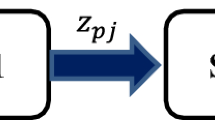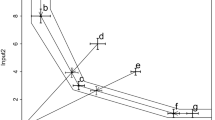Abstract
Data envelopment analysis (DEA) is a mathematical programming approach for evaluating the relative efficiency of decision making units (DMUs) in organizations. The conventional DEA methods require accurate measurement of both the inputs and outputs. However, the observed values of the input and output data in real-world problems are often imprecise or vague. Fuzzy set theory is widely used to quantify imprecise and vague data in DEA models. In this paper, we propose a four-step bounded fuzzy DEA model, where the inputs and outputs are assumed to be fuzzy numbers. In the first step, we create a hypothetical fuzzy anti-ideal DMU and calculate its best fuzzy relative efficiency. In the second step, we propose a pair of fuzzy DEA models to obtain the upper- and the lower-bounds of the fuzzy efficiency, where the lower-bound is at least equal to the fuzzy efficiency of the anti-ideal DMU, and the upper-bound is at most equal to one. In step three, we use multi-objective programming to solve the proposed fuzzy programs. In the fourth step, we propose a new method for ranking the bounded fuzzy efficiency scores. We also present a case study to demonstrate the applicability of the proposed model and the efficacy of the procedures and algorithms in measuring the safety performance of eight semiconductor facilities.


Similar content being viewed by others
Notes
The subscripts 1,2,...,\(n\ \)present the ranking number of DMU\(_{i}\)
The name of the company has been changed to protect their anonymity
References
Charnes, A., Cooper, W.W., Rhodes, E.L.: Measuring the efficiency of decision making units. Eur. J. Oper. Res. 2(6), 429–444 (1978)
Banker, R.D., Charnes, A., Cooper, W.W.: Some methods for estimating technical and scale inefficiencies in data envelopment analysis. Manag. Sci. 30(9), 1078–1092 (1984)
Cooper, W.W., Seiford, L.M., Tone, K.: Introduction to Data Envelopment Analysis and Its Uses with DEA Solver Software and References. Springer, New York (2006)
Emrouznejad, A., Parker, B.R., Tavares, G.: Evaluation of research in efficiency and productivity: a survey and analysis of the first 30 years of scholarly literature in DEA. Soc. Econ. Plan. Sci. 42(3), 151–157 (2008)
Cook, W.D., Seiford, L.M.: Data envelopment analysis (DEA)—thirty years on. Eur. J. Oper. Res. 192, 1–17 (2009)
Zadeh, L.A.: Fuzzy sets. Inf. Control 8, 338–353 (1965)
Sengupta, J.K.: A fuzzy systems approach in data envelopment analysis. Comput. Math. Appl. 24(8–9), 259–266 (1992)
Kao, C., Liu, S.T.: A mathematical programming approach to fuzzy efficiency ranking. Int. J. Prod. Econ. 86(2), 145–154 (2003)
Hatami-Marbini, A., Saati, S., Tavana, M.: An ideal-seeking fuzzy data envelopment analysis framework. Appl. Soft Comput. 10(4), 1062–1070 (2010)
Guo, P., Tanaka, H.: Fuzzy DEA: a perceptual evaluation method. Fuzzy Set Syst. 119(1), 149–160 (2001)
Lertworasirikul, S., Fang, S.C., Joines, J.A., Nuttle, H.L.W.: Fuzzy data envelopment analysis (DEA): a possibility approach. Fuzzy Set Syst. 139(2), 379–394 (2003)
Hatami-Marbini, A., Emrouznejad, A., Tavana, M.: A taxonomy and review of the fuzzy data envelopment analysis literature: two decades in the making. Eur. J. Oper. Res. 214, 457–472 (2011)
Bellman, R.E., Azadeh, L.: Decision making in a fuzzy environment. Manag. Sci. 17, 141–164 (1970)
Despotis, D.K., Smirlis, Y.G.: Data envelopment analysis with imprecise data. Eur. J. Oper. Res. 140, 24–36 (2002)
Wang, Y.M., Greatbanks, R., Yang, J.: Interval efficiency assessment using data envelopment analysis. Fuzzy Set Syst. 153, 347–370 (2005)
Wang, Y.M., Luo, Y.: DEA efficiency assessment using ideal and anti-ideal decision making units. Appl. Math. Comput. 173, 902–915 (2006)
Wu, D.: A note on DEA efficiency assessment using ideal point: an improvement of Wang and Luo’s model. Appl. Math. Comput. 183, 819–830 (2006)
Chen, J.X.: A comment on DEA efficiency assessment using ideal and anti-ideal decision making units. Appl. Math. Comput. 219, 583–591 (2012)
Wang, Y.M., Yang, J.B.: Measuring the performances of decision-making units using interval efficiencies. J. Comput. Appl. Math. 198, 253–267 (2007)
Wang, N.S., Yi, R.H., Wang, W.: Evaluating the performances of decision-making units based on interval efficiencies. J. Comput. Appl. Math. 216, 328–343 (2008)
Azizi, H., Wang, Y.M.: Improved DEA models for measuring interval efficiencies of decision-making units. Measurement 46, 1325–1332 (2013)
Jahanshahloo, G.R., Hosseinzadeh Lotfi, F., Rezaie, V., Khanmohammadi, M.: Ranking DMUs by ideal points with interval data in DEA. Appl. Math. Model. 35, 218–229 (2011)
Sun, J., Wu, J., Guo, D.: Performance ranking of units considering ideal and anti-ideal DMU with common weights. Appl. Math. Model. 37(9), 6301–6310 (2013)
Azadeh, A., Mohammad Fam, I., Nazifkar, N.: The evaluation and improvement of safety behaviors among contractors of a large steel manufacturing company by fuzzy data envelopment analysis. J. Chin. Inst. Eng. 33(6), 823–832 (2010)
Mohd Said, S., Sanwari, S.R., Said, F.: Technical and scale efficiency in Malaysian manufacturing industries in the presence of industrial accidents. World Appl. Sci. J. 24(7), 862–871 (2013)
El-Mashaleh, M.S., Rababeh, S.M., Hyari, K.H.: Utilizing data envelopment analysis to benchmark safety performance of construction contractors. Int. J. Proj. Mang. 28(1), 61–67 (2010)
Rajaprasad, S.V.S., Prasada Rao, Y.V.S.S.V., Venkata Chalapathi, P.: Evaluation of safety performance in Indian construction segments using data envelope analysis. Asia Pac. J. Bus Manag. 4(1), 1–13 (2013)
Shen, Y., Hermans, E., Brijs, T., Wets, G., Vanhoof, K.: Road safety risk evaluation and target setting using data envelopment analysis and its extensions. Accid. Anal. Prev. 48, 430–441 (2012)
Kelle, P., Schneider, H., Raschke, C., Shiraziff, H.: Highway improvement project selection by the joint consideration of cost-benefit and risk criteria. J. Oper. Res. Soc. 64, 313–325 (2013)
Noroozzadeh, A., Sadjadi, S.: A new approach to evaluate railways efficiency considering safety measures. Decis. Sci. Lett. 2(2), 71–80 (2013)
Mark, B.A., Jones, C.B., Lindley, L., Ozcan, Y.A.: An examination of technical efficiency, quality, and patient safety in acute care nursing units. Policy Polit. Nurs. Pract. 10(3), 180–186 (2009)
Entani, T., Maeda, Y., Tanaka, H.: Dual models of interval DEA and its extension to interval data. Eur. J. Oper. Res. 136(1), 32–45 (2002)
Charnes, A., Cooper, W.W.: Programming with linear fractional functionals. Nav. Res Logist. Q. 9, 181–186 (1962)
Kaufmann, A., Gupta, M.M.: Introduction to Fuzzy Arithmetic Theory and Applications. Van Nostrand Reinhold, New York (1991)
Zimmermann, H.J.: Fuzzy Sets Theory and Its Applications. Kluwer Academic Publishers, Boston (1996)
Dubois, D., Prade, H.: Operations on fuzzy numbers. Int. J. Syst. Sci. 9, 613–626 (1978)
Klir, G.J., Yuan, B.: Fuzzy Sets and Fuzzy Logic: Theory and Applications. Prentice-Hall, New York (1995)
Ramík, J., Rímánk, J.: Inequality relation between fuzzy numbers and its use in fuzzy optimization. Fuzzy Set Syst. 16, 123–138 (1985)
Dubois, D., Prade, H.: Systems of linear fuzzy constraints. Fuzzy Set Syst. 3, 37–48 (1980)
Wang, Y.M., Luo, Y., Liang, L.: Fuzzy data envelopment analysis based upon fuzzy arithmetic with an application to performance assessment of manufacturing enterprises. Expert Syst. Appl. 36(3), 5205–5211 (2009)
Hwang, C.L., Masud, A.S.M.: Multiple Objective Decision Making-Methods and Applications: A State-of-the-Art Survey. Springer, Berlin (1979)
Steuer, R.E.: Multiple Criteria Optimization: Theory, Computation, and Application. Wiley, New York (1986)
Freed, N., Glover, F.: Simple but powerful goal programming model for discriminant problems. Eur. J. Oper. Res. 7, 44–60 (1981)
Freed, N., Glover, F.: Resolving certain difficulties and improving the classification power of the LP discriminant analysis procedure. Decis. Sci. 17, 589–595 (1986)
Acknowledgments
The authors would like to thank the anonymous reviewers and the editor-in-chief for their constructive comments and suggestions. Adel Hatami-Marbini also likes to thank the FRS-FNRS for the financial support he received as a chargé de recherches at the Université catholique de Louvain for this research project
Author information
Authors and Affiliations
Corresponding author
Additional information
Communicated by Jyh-Horng Chou.
Rights and permissions
About this article
Cite this article
Hatami-Marbini, A., Tavana, M., Gholami, K. et al. A Bounded Data Envelopment Analysis Model in a Fuzzy Environment with an Application to Safety in the Semiconductor Industry. J Optim Theory Appl 164, 679–701 (2015). https://doi.org/10.1007/s10957-014-0559-x
Received:
Accepted:
Published:
Issue Date:
DOI: https://doi.org/10.1007/s10957-014-0559-x




